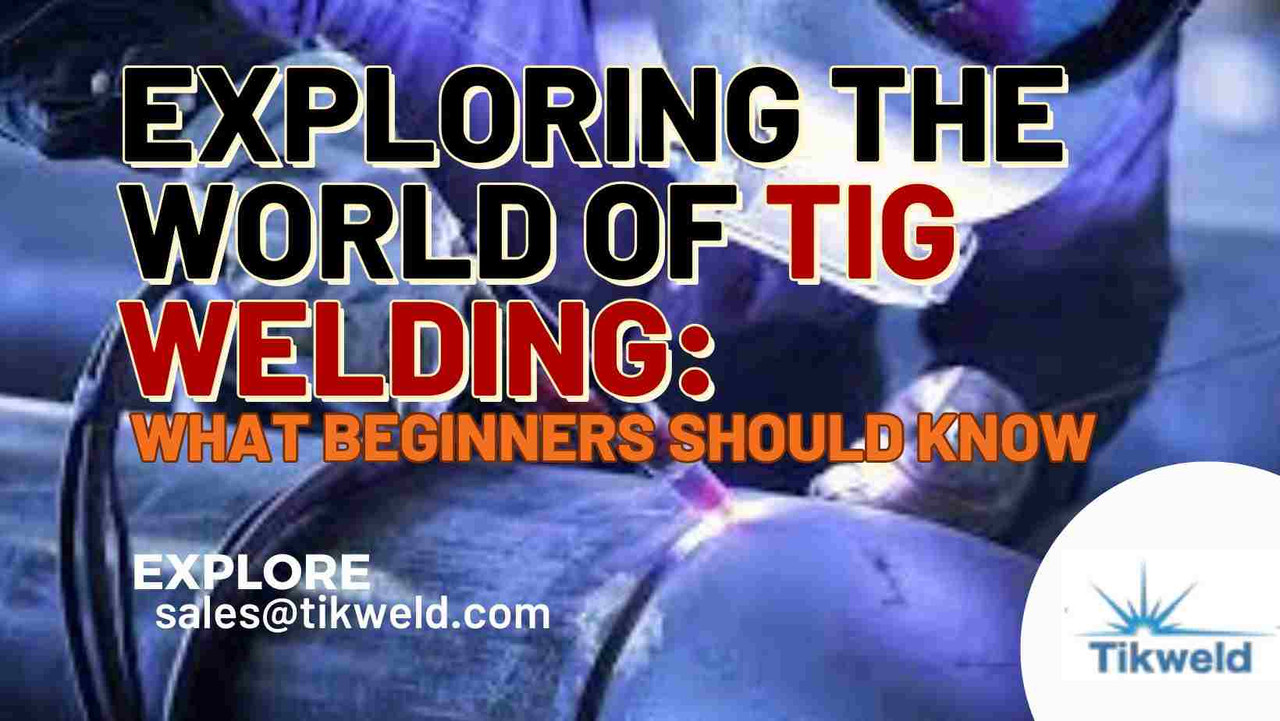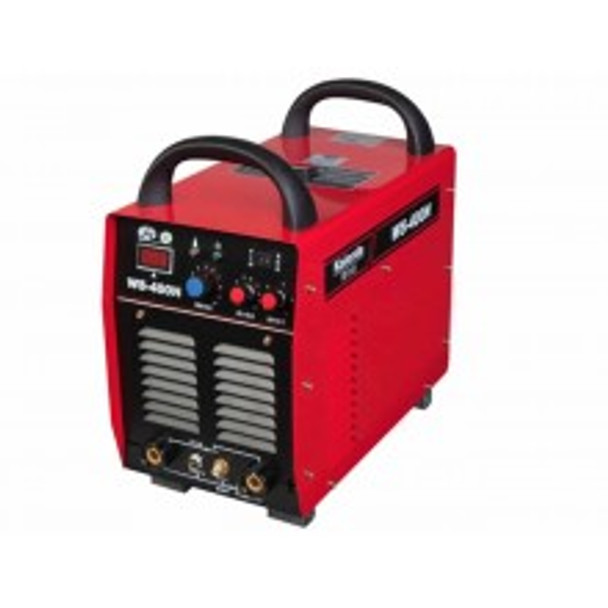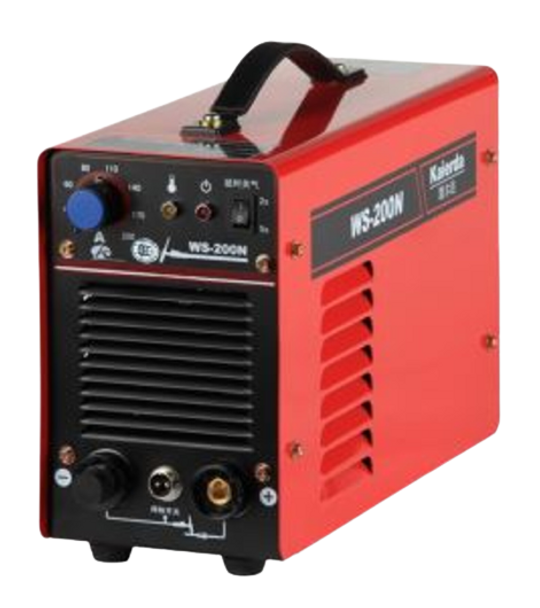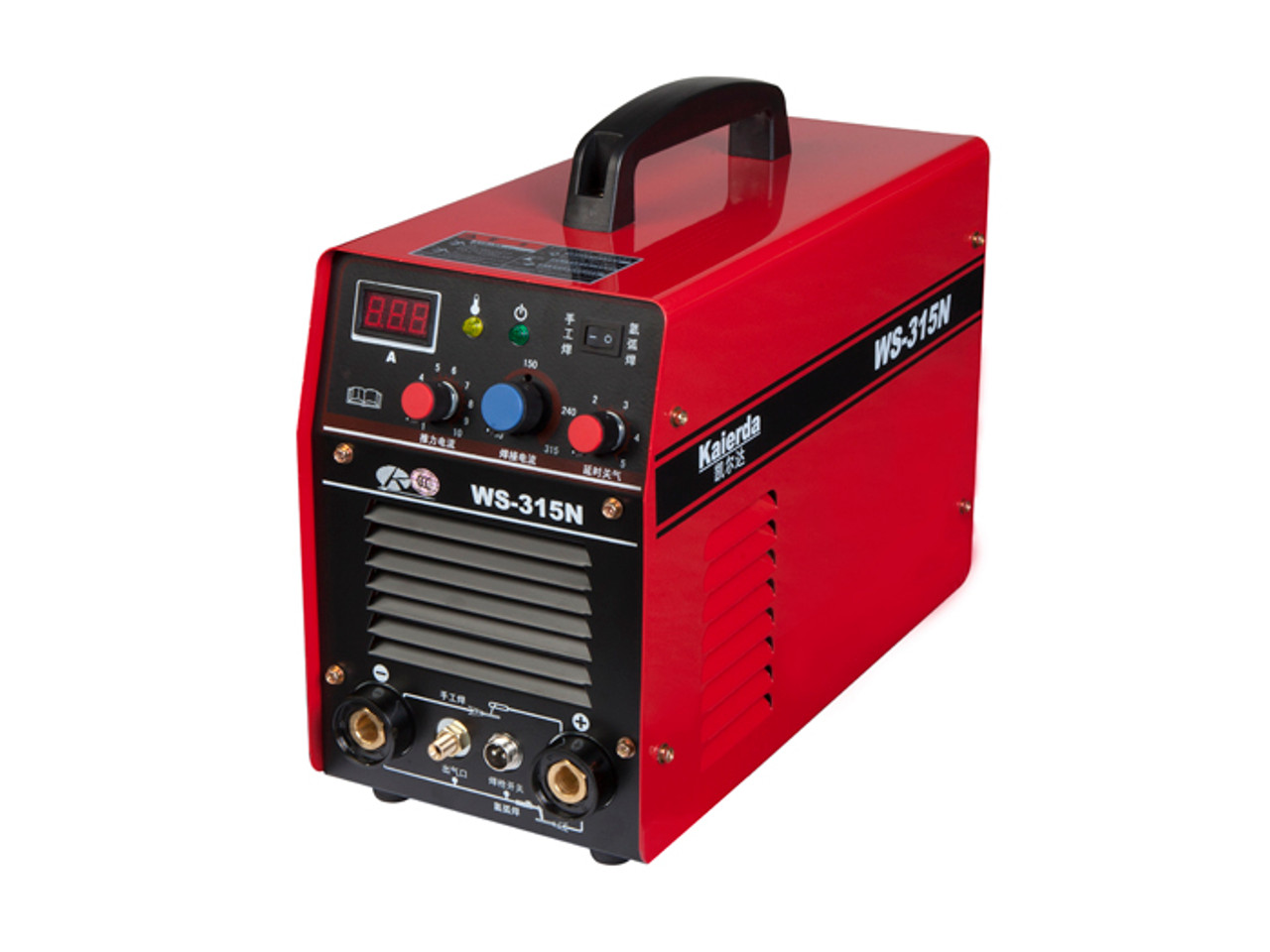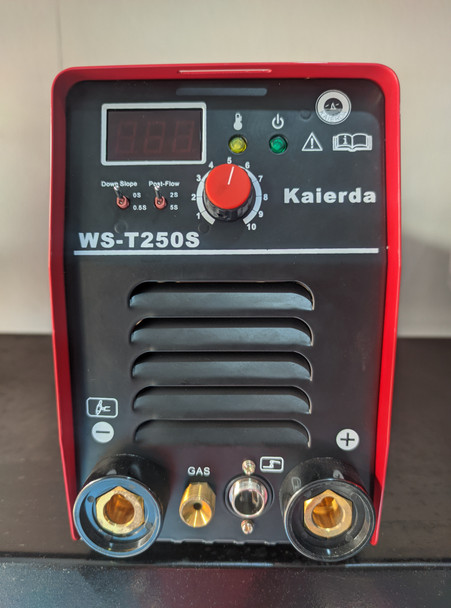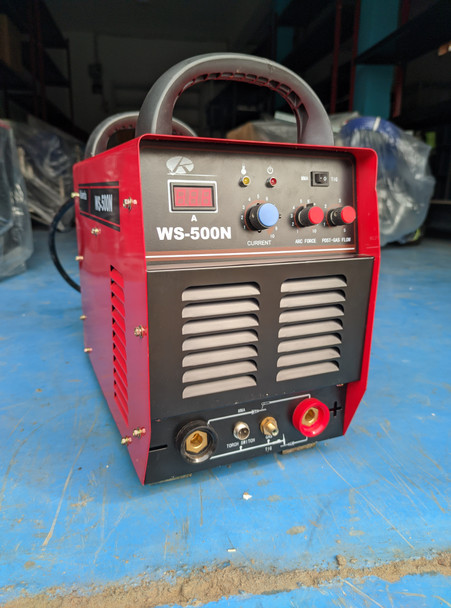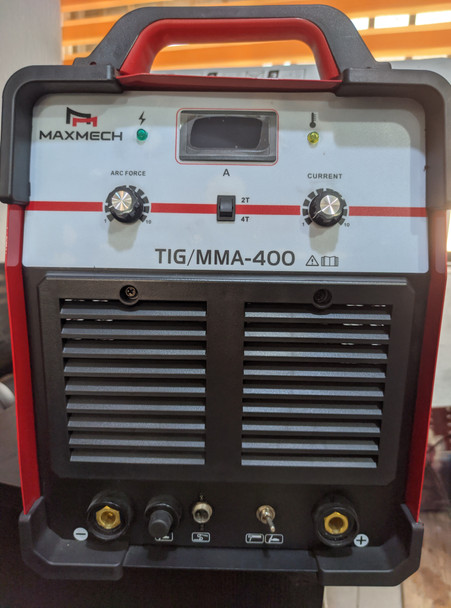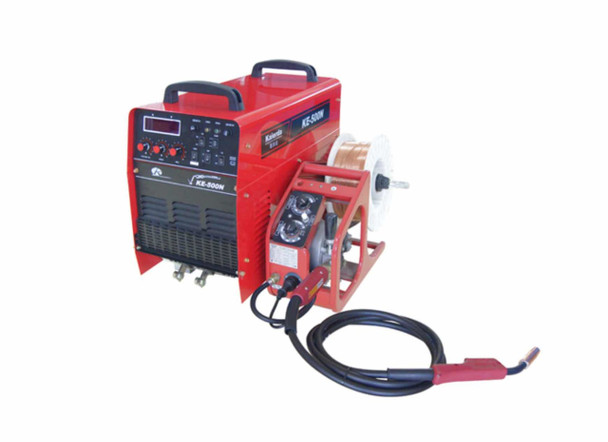Exploring the World of TIG Welding: What Beginners Should Know
Tungsten Inert Gas (TIG) welding, commonly known as Gas Tungsten Arc Welding (GTAW), is a welding procedure used to produce accurate, clean welds on a variety of materials. It is particularly suitable for critical welding applications in aerospace, food equipment, high-purity processing, and motorsports. This is one of the most versatile and precise welding processes, employed in a variety of sectors. TIG welding provides unmatched control, resulting in clean, high-quality welds.
Buy Online... Kaierda Tig Welding machine WS400N
Central to this welding technique are TIG welding machines, which play a pivotal role in achieving clean and precise welds. These machines facilitate the fusion of metals using a non-consumable tungsten electrode and an inert shielding gas, ensuring a controlled and immaculate welding experience. For example the Maxmech Inverter Welding Machine TIG/MMA 400.
TIG Welding is a great option for welding non-ferrous metals together and compared to other types of welding, TIG takes more time to master, making it a slower process with a greater production cost. It uses an AC/DC power source, a non-consumable tungsten electrode, and inert gas to form an arc and create a weld.
In this article, we will delve into the TIG welding process, its applications, advantages, and key considerations for achieving exceptional welds.
Basics of TIG Welding
Tungsten Inert Gas (TIG) welding, also known as Gas Tungsten Arc Welding (GTAW), is a precise and versatile welding process commonly used in various industries. In TIG welding, a non-consumable tungsten electrode generates the arc, and a shielding gas (typically argon or helium) protects the weld area from atmospheric contamination. What sets TIG welding apart is its ability to produce high-quality welds on a variety of materials, including stainless steel, aluminum, and exotic alloys. However, TIG welding is comparatively more complex and difficult to master, and furthermore, it is significantly slower than most other welding techniques. TIG welding is most commonly used to weld thin sections of stainless steel and non-ferrous metals such as aluminum, magnesium, and copper alloys.
Components of a TIG welding setup
A typical TIG welding setup consists of the following components:
- Power Source: The power source in TIG welding supplies the electrical energy needed to generate the welding arc. TIG welding machines are available in various sizes and power outputs, allowing for flexibility in different applications. The power supply can be either a direct current (DC) or an alternating current (AC) source, depending on the type of metal being welded and the desired arc characteristics.
- Tungsten Electrode: The non-consumable tungsten electrode is a crucial component that carries the electric current to the welding arc. Tungsten is chosen for its high melting point and stability, ensuring it doesn't break or wear away during the welding process. The most common types of tungsten electrodes are pure tungsten, thoriated tungsten, ceriated tungsten, lanthanated tungsten, and zirconiated tungsten.
- Shielding Gas Supply: Argon or a mixture of gases serves as the shielding gas in TIG welding. This gas protects the weld puddle from atmospheric elements, preventing oxidation and contamination.
- Welding Torch: The TIG welding torch is designed to hold and control the tungsten electrode, as well as to regulate the flow of shielding gas. It also allows for precise control of the welding parameters.The torch can be either air-cooled or water-cooled, depending on the welding current and duration. The torch also has a trigger or a foot pedal to control the arc initiation and termination.
- Filler Metal: A filler metal, which is optional but often used to fill the gap between the base metals and increase the strength and durability of the weld. The filler metal can be either a solid wire or a rod, which is fed manually or automatically into the weld pool. The filler metal should match the composition and properties of the base metal as closely as possible, or be compatible with it
How TIG welding differs from other welding techniques
TIG welding differs from other welding techniques in several ways, such as:
- TIG welding uses a non-consumable tungsten electrode, while other welding techniques use consumable electrodes that melt and become part of the weld. This means that TIG welding does not produce slag or spatter, which can affect the weld quality and appearance. It also means that TIG welding requires a separate filler metal, which can be added or omitted depending on the weld design and requirements.
- Unlike some other welding techniques, TIG welding uses an inert shielding gas, while others use flux or active gases that react with the weld pool and the arc. This means that TIG welding produces cleaner and more consistent welds, as there is no risk of porosity, cracking, or contamination from the gas or the flux. It also means that TIG welding can weld a wider range of metals, as it does not depend on the chemical compatibility of the gas or the flux with the base metal.
- TIG welding requires more skill and coordination than other welding techniques, as the operator has to control the arc length, the filler metal feed, and the travel speed simultaneously. This means that TIG welding has a steeper learning curve and a higher degree of difficulty than other welding techniques. It also means that TIG welding can achieve more precise and intricate welds, as the operator has more flexibility and accuracy in manipulating the weld pool and the arc.
Buy Online... Kaierda TIG Welding Machine WS200N
Advantages of TIG Welding
1. Precision and control in welding
One of the main advantages of TIG welding is the precision and control it offers over the welding process. TIG welding allows the operator to adjust the heat input, the arc length, the filler metal feed, and the travel speed according to the specific requirements of the weld. This results in high-quality welds that are consistent, accurate, and aesthetically pleasing. TIG welding is ideal for welding thin sections of metal, as well as complex shapes and contours. TIG welding also produces a stable arc that can be started and stopped smoothly, without creating any spatter or slag.
2. Versatility in welding different materials
Another advantage of TIG welding is the versatility it provides in welding different materials. TIG welding can weld almost any metal, including stainless steel, aluminum, magnesium, copper, titanium, and nickel alloys. TIG welding can also weld dissimilar metals, as long as they are compatible with the filler metal and the shielding gas. TIG welding can handle a wide range of thicknesses, from 0.5 mm to 6 mm, and can produce welds with various joint configurations, such as butt, lap, corner, edge, and tee. TIG welding can also weld in various positions, such as flat, horizontal, vertical, and overhead.
3. Cleanliness of the welding process
A third advantage of TIG welding is the cleanliness of the welding process. TIG welding uses an inert shielding gas, such as argon or helium, to protect the weld area and the electrode from oxidation or contamination. This means that TIG welding does not produce any smoke, fumes, flux, or slag, which can affect the weld quality and the operator’s health. TIG welding also does not require any post-weld cleaning, as the welds are free of defects and impurities.TIG welding is an environmentally friendly welding method that reduces waste and emissions
Getting Started with TIG Welding
Safety precautions for TIG welding
TIG welding is a safe and rewarding activity when done properly, but it also involves certain hazards that require attention and precaution. Some of the common dangers of TIG welding include:
- Electric shock: TIG welding uses high voltage electricity to create the arc. Accidental contact with live electrical parts can cause serious injury or death. To prevent electric shock, you should always wear dry insulating gloves, insulate yourself from work and ground, do not touch live electrodes or electrical parts, and verify that the torch head is firmly attached to the torch body.
- UV radiation: TIG welding produces intense UV light that can damage the eyes and skin. Prolonged exposure to UV radiation without proper protection can lead to conditions like arc eye, skin burns, and long-term vision problems. To protect yourself from UV radiation, you should always wear a welding helmet with a suitable shade lens, welding gloves, and protective clothing that covers your arms and legs.
- Fumes and gases: TIG welding can generate harmful fumes and gases from the materials being welded, such as metals and coatings. Inhaling these substances can cause respiratory issues, dizziness, nausea, or chronic health problems. To avoid exposure to fumes and gases, you should always weld in a well-ventilated area, use a fume extractor or a respirator if necessary, and follow the material safety data sheets for the products you are using.
- Fire and explosion: TIG welding involves working with flammable materials and gases, such as argon or helium. Improper handling or storage of these materials can lead to fire or explosion. To prevent fire and explosion, you should always keep combustible materials away from the welding area, check for gas leaks before welding, and have a fire extinguisher nearby.
Buy Online... Kaierda TIG Welding Machine WS 315N
Selecting the right TIG welding equipment
To achieve the best results with TIG welding, you need to select the right equipment for your application. Some of the factors to consider when choosing a TIG welder are:
- Amperage range: You want a machine that provides the widest amperage range at the best possible cost. A TIG welder with a narrow amperage range can limit the metals you can weld and the thicknesses you can handle. A machine with a range of 5 amps to 250 amps can weld thin materials like 24 gauge stainless steel and up to ¼ inch thick aluminum.
- AC/DC capability: You need a machine that can switch between AC and DC modes, depending on the type of metal you are welding. AC mode is used for welding aluminum and magnesium, as it provides a cleaning action that removes the oxide layer from the metal surface. DC mode is used for welding steel and steel alloys, as it provides better penetration and heat control.
- Duty cycle: You need a machine that can handle the duration and frequency of your welding. Duty cycle is the percentage of time that a machine can operate at a given output without overheating. For example, a machine with a 60% duty cycle at 200 amps can weld continuously for 6 minutes out of 10 minutes at 200 amps. A machine with a higher duty cycle can weld longer and more often than a machine with a lower duty cycle.
- Portability: You need a machine that is easy to transport and store, especially if you are welding in different locations or have limited space. A machine that is lightweight, compact, and has a carrying handle or a cart can make your welding more convenient and comfortable.
- User-friendly controls: You need a machine that is simple to operate and adjust, especially if you are a beginner or have varying welding needs. A machine that has a digital display, a foot pedal or a fingertip control, and easy-to-access knobs and buttons can make your welding more efficient and enjoyable.
Setting up a TIG welding workstation
To start TIG welding, you need to set up your workstation properly and safely. The following steps and instructions show how to set up a typical TIG welding workstation:
- Set up your workstation in a well-lit and ventilated area. Ensure there is sufficient space for maneuvering and positioning the workpiece. Secure the workpiece in a stable position, using clamps or fixtures as needed.
- Connect the torch: If you are using an air-cooled torch, use the adapter from your accessory package and plug the torch into the front of your machine. Also connect your gas hose and regulator. If you are using a water-cooled torch, connect the water hoses and the power cable to the machine and the torch.
- Connect the remote control: Plug your foot pedal or fingertip control into the machine. This will allow you to control the arc initiation and termination, and the current output.
- Connect the work clamp: Plug your work clamp (sometimes referred to as a ground clamp) into the machine. Clamp the other end to your work piece or work table. Make sure the clamp has a good contact with the metal and is not too far from the welding area.
- Select the polarity: For aluminum welding, switch your amperage setting on the front panel to AC. For steel and steel alloy welding, switch your amperage setting to DCEN. (For stick welding, switch your amperage setting to DCEP.)
- Prepare the tungsten: Grind your tungsten to a point. When welding on aluminum, the tungsten will begin to form a ball. If the ball grows to the same diameter as your tungsten, repoint the tungsten. Grind in the long direction and make the point roughly 2-1/2 times as long as the diameter. Use a 200 grit or finer grinding wheel. Do not use the wheel for other jobs or tungsten can become contaminated, causing lower weld quality.
- Assemble the torch: Loosen the back cap and remove the tungsten from your torch. Remove the nozzle and copper collet pieces from your torch. Put the collet and collet body back into the torch and tighten. Put the nozzle back onto the torch.
- Install the tungsten: Place the tungsten into the collet. Leave about 1/8 to 1/4 inch sticking out of the collet (not more than the diameter of the cup). Tighten the back cap.
- Check and connect power: Make sure the power supply you are connecting to matches the rating of your machine (see rating label on unit). If your machine is supplied with a plug, plug it into the appropriate power outlet when you are ready to begin welding. You may need to purchase a plug to match your receptacle. If your machine is not supplied with a plug, connect according to the procedure provided in the Owner’s Manual.
Buy Online... Kaierda Inverter TIG/MMA Welding Machine WS-T250S
TIG Welding Techniques for Beginners
Proper Torch Handling and Positioning.
- Grip and Ergonomics:
Begin by holding the TIG welding torch with a comfortable and stable grip. Maintain a relaxed but firm hold to ensure precise control during the welding process.
- Torch Angle:
Pay attention to the angle of the torch relative to the workpiece. In TIG welding, maintaining a consistent torch angle is crucial for achieving optimal weld penetration and minimizing heat distortion. The torch should be held at a comfortable angle and distance from the workpiece, usually between 10 and 20 degrees. Experiment with different angles to find the most effective position for your specific welding project.
- Travel Speed:
Control the speed at which you move the torch across the workpiece. Consistent travel speed helps achieve uniform weld beads and prevents overheating. Practice maintaining a steady and controlled motion to enhance your welding skills. The torch movement should be consistent with the direction and speed of the weld and should not be moved too fast or too slow, as this can affect the weld quality and appearance. A good rule of thumb is to move the torch about one electrode diameter for every ampere of current.
Controlling the Welding Arc and Puddle
Another crucial aspect of TIG welding is how you control the welding arc and the puddle. The arc is the electric discharge that occurs between the tungsten electrode and the base metal. The puddle is the molten pool of metal that forms as a result of the arc. The arc and the puddle should be maintained at a suitable size and shape, depending on the thickness and type of the metal being welded.
- Arc Initiation:
Develop a steady and controlled technique for initiating the arc. Avoid rapid or erratic movements, as this can lead to tungsten electrode contamination. Use a scratch start or lift arc method, depending on your welding machine.
- Arc Length:
Maintain a consistent arc length between the tungsten electrode and the workpiece. The ideal arc length varies with different materials and welding conditions. The arc should be as short as possible, without touching the base metal or the filler rod. The arc length should be about the same as the diameter of the electrode. Too short of an arc can result in electrode sticking, while too long of an arc may lead to insufficient heat and poor penetration.
- Puddle Length:
The puddle should be about two to three times the diameter of the electrode. The puddle should also be fluid and uniform, without any ripples or bubbles. The puddle should be controlled by the heat input, the filler metal feed, and the travel speed.
- Arc Control Techniques:
Experiment with different arc control techniques, such as weaving or oscillating the torch, to achieve the desired weld profile. These techniques can help distribute heat evenly across the weld joint, preventing overheating or underfilling.
Adding Filler Metal And Creating Weld Beads
- Filler Metal Selection:
Choose the appropriate filler metal based on the material being welded. Ensure compatibility with the base metal to achieve a strong and durable weld. Refer to welding charts or consult with experienced welders for guidance on filler metal selection.
- Adding Filler Metal:
Introduce the filler metal into the leading edge of the weld puddle in a controlled manner. Maintain a steady hand to control the deposition rate and prevent excess or insufficient filler metal. Filler metal should be added only when needed, and in the right amount and location. Filler metal should be held at a 15 to 20 degree angle from the workpiece, and about 1/8 inch away from the puddle. Practice controlling the filler metal's movement to create uniform and aesthetically pleasing weld beads.
- Weld Bead Techniques:
Weld beads should be smooth and even, without any undercutting or overlapping. Weld beads should also be consistent in width and height, without any gaps or cracks. Weld beads should be created by moving the torch and the filler metal in a coordinated manner, following the joint configuration and the weld design.
Buy Online... Kaierda Tig Welding machine WS500N
Common Challenges and Troubleshooting Tips
TIG welding can produce high-quality welds, but it also poses some challenges that can affect the weld quality and appearance. Some of the common issues that TIG welders face are:
Porosity:
Porosity is the presence of small holes or voids in the weld, caused by trapped gas or air. Porosity can weaken the weld and make it prone to cracking. Porosity can be caused by several factors, such as contaminated base metal or filler metal, insufficient shielding gas, improper gas flow rate, excessive arc length, or improper cleaning of the weld area.
Troubleshooting Tips:
- Clean the base metal thoroughly before welding.
- Ensure proper gas flow and shielding to prevent atmospheric contamination.
- Adjust travel speed and filler metal deposition for optimal penetration.
Spatter:
Spatter is the formation of small metal droplets that are ejected from the weld pool and stick to the surrounding metal or the torch. Spatter can affect the weld appearance and cause post-weld cleaning problems. Spatter can be caused by several factors, such as too high or too low current, improper polarity, dirty or oxidized electrode, improper torch angle, or excessive gas flow rate.
Troubleshooting Tips:
- Clean and prepare base metal surfaces properly.
- Adjust gas flow to achieve proper coverage.
- Verify that the filler metal matches the welding requirements.
Inconsistent welds:
Inconsistent welds are welds that vary in width, height, penetration, or color, or have defects such as undercutting, overlapping, or cracking. Inconsistent welds can affect the weld strength and durability, as well as the weld aesthetics. Inconsistent welds can be caused by several factors, such as improper torch movement, inconsistent filler metal feed, unstable arc, incorrect machine settings, or operator fatigue.
Troubleshooting Tips:
- Maintain a consistent arc length throughout the weld.
- Control travel speed for uniform bead appearance.
- Practice maintaining a steady torch angle.
Buy Online... Maxmech Inverter Welding Machine TIG/MMA-400
Troubleshooting tips for beginners to overcome challenges
To overcome the common challenges of TIG welding, beginners should follow some basic troubleshooting tips, such as:
1. Difficulty Initiating Arc:
Possible Causes:
- Incorrect tungsten electrode type or size.
- Insufficient clean contact with the workpiece.
Tips:
- Use the appropriate tungsten electrode for the material.
- Ensure a clean workpiece surface and proper grounding.
2. Tungsten Electrode Contamination:
Possible Causes:
- Touching the electrode to the workpiece or filler metal.
- Inadequate gas shielding.
Tips:
- Practice maintaining a stable arc without touching the electrode.
- Check and adjust gas flow for effective shielding.
3. Overheating or Underheating:
Possible Causes:
- Incorrect amperage settings.
- Inconsistent travel speed.
- Incorrect arc length.
Tips:
- Adjust amperage settings based on material thickness.
- Maintain a steady travel speed and arc length.
4. Inadequate Penetration
Possible Causes:
- Insufficient amperage.
- Incorrect tungsten electrode type.
- Poor joint preparation.
Tips:
- Increase amperage for better penetration.
- Ensure the correct tungsten electrode and proper joint preparation.
Buy Online...KAIERDA MIG MAG CO2 MMA STICK WELDING MACHINE MIG500-C
Practice and Skill Development
TIG welding is a skill that requires a lot of practice and patience to master. Unlike other welding processes, TIG welding demands a high level of coordination, precision, and heat control from the welder. TIG welding also involves working with different metals, thicknesses, positions, and joints, which adds to the complexity and challenge of the process. Therefore, practicing TIG welding is essential for improving your technique, confidence, and quality of welds. By practicing regularly, you can develop muscle memory, hand-eye coordination, and arc stability, as well as learn from your mistakes and correct them. Practice also helps you to adapt to different welding situations and conditions, and to overcome common problems and difficulties. As the saying goes, practice makes perfect, and this is especially true for TIG welding.
If you are new to TIG welding, you may wonder what kind of exercises and projects you should start with to build your skills and experience. Here are some suggestions that can help you progress from beginner to intermediate level:
- Start with simple practice runs on scrap metal. Use 1/8 inch mild steel and practice making single beads with filler, multiple overlapping beads, lap joints, T joints, outside corner joints, and butt joints. Do this in the flat position first, then move on to horizontal, vertical, and overhead positions. This will help you get familiar with the torch movement, filler metal feed, arc length, and puddle control.
- Try welding different metals, such as stainless steel, aluminum, copper, and titanium. Each metal has its own characteristics, such as melting point, conductivity, and oxide formation, that affect the welding process. You will need to adjust your machine settings, polarity, shielding gas, filler metal, and technique accordingly. Start with steel, then move on to stainless steel, aluminum, and other metals.
- Work on some simple projects that involve welding different shapes and sizes of metal. For example, you can make a fire pit, a bike rack, a tool cart, a coffee table, or a sculpture. These projects will allow you to apply your skills in a practical and creative way, as well as challenge you to weld different joint types, positions, and angles.
Related article:
Understanding TIG vs MIG welding machines: A comprehensive guide
Essential Welding Equipment for Beginners: A Comprehensive Guide
Master the Art of Precision Welding with High-Quality TIG Welding machine
Conclusion
TIG welding is an advanced and rewarding welding process that can produce high-quality welds on almost any metal. However, TIG welding also requires a lot of skill, practice, and patience to master. In this guide, we have covered the basics of TIG welding, such as:
- What is TIG welding and how does it work
- What are the components of a TIG welding setup
- How does TIG welding differ from other welding techniques
- What are the advantages of TIG welding
- How to get started with TIG welding
- How to perform TIG welding techniques for beginners
- How to address common challenges and troubleshoot problems
- How to practice and develop your TIG welding skills
We hope that this guide has given you a solid foundation and a clear direction for your TIG welding journey. We encourage you to continue learning and practicing TIG welding, as it is a skill that can open up many opportunities and possibilities for you. Whether you want to weld for fun, for hobby, or for work, TIG welding can help you create amazing projects and products that you can be proud of.
Remember, TIG welding is not easy, but it is not impossible either. With enough dedication, discipline, and enthusiasm, you can achieve your TIG welding goals and become a proficient and confident welder. For more information or if you need any Help choosing or buying a TIg welder feel free to contact us at tikweld.com

